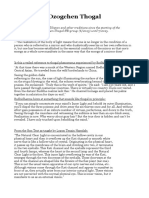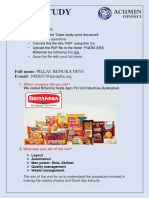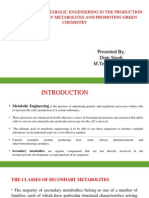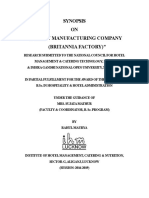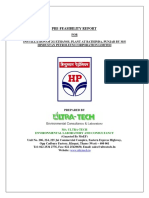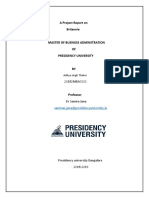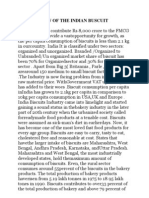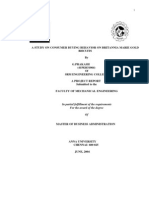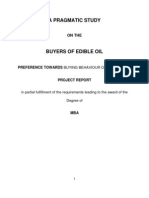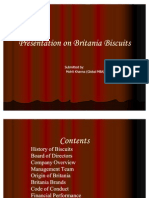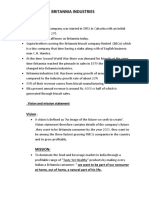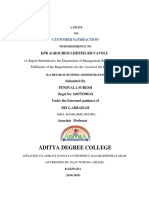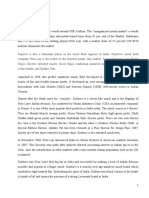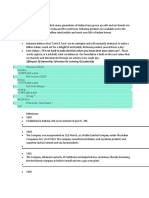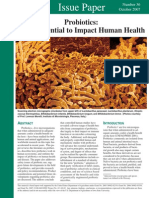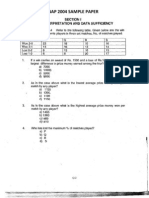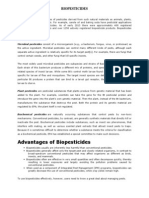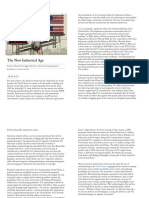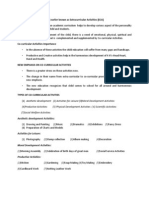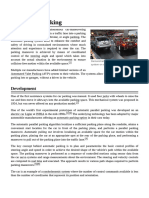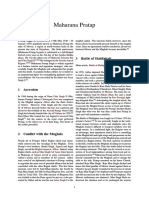Britannia SIP
Britannia SIP
Uploaded by
Arup ChakrabortyCopyright:
Available Formats
Britannia SIP
Britannia SIP
Uploaded by
Arup ChakrabortyOriginal Title
Copyright
Available Formats
Share this document
Did you find this document useful?
Is this content inappropriate?
Copyright:
Available Formats
Britannia SIP
Britannia SIP
Uploaded by
Arup ChakrabortyCopyright:
Available Formats
1
Britannia Industries Ltd.
6-Weeks Summer Training Report
Amity Institute of Biotechnology
Amity University, Haryana
Production and Manufacturing Process of Jim-Jam
Submitted to:-
ACKNOWLEDGEMENT
Every project big or small is successful largely due to the effort of a number of wonderful people who
have always given their valuable advice or lent a helping hand. I sincerely appreciate the inspiration;
support and guidance of all those people who have been instrumental in making this project a success.
I, Dipti Singh Sambyal, Student of Amity Institute Biotechnology, Amity University is extremely
grateful to Britannia Industries Ltd. for the confidence bestowed in me and entrusting my project
entitled Production and Manufacturing process of Jim-Jam.
At this juncture I feel deeply honoured in expressing my sincere thanks to ___________________
Production Officer for making the resources available at right time and providing valuable insights
leading to the successful completion of my project.
We express my gratitude to Dr. S.M. Paul Khurana, HOD, AIB for arranging the summer training
in good schedule.
I would also like to thank all the faculty members of Amity Institute of Biotechnology for their
critical advice and guidance without which this project would not have been possible.
DATE PLACE Gurgaon
NAME Dipti Singh Sambyal
AIB, AUH
DECLARATION
We hereby declare that the Industrial Training Report entitled Production and
Manufacturing Process of Jim-Jam is an authentic record of my work as requirements of
6-weeks Industrial Training during the period from 10/07/2014 to 25/08/2014 for the degree
of M.Tech.(Bio-Technology), Amity Institute of biotechnology, Amity university, Haryana
under the kind guidance of _________________________, Production Officer, Britannia
Industries Ltd.
(Signature of mentor)
(Signature of student)
___________________
Dipti Singh Sambyal
Index
Company Overview
Evolution of Britannia
History of biscuits
Specifications and classification of biscuits
Products
o Overall
o Plant specific
Production lines
Biscuit manufacturing Process
Production Process
o Ingredients used in Biscuits
o Ingredient Blends
o Ingredients in Jam
o Ingredients in Cream
o Production Area
Individual day data
Cumulative data and graphs obtained
o Effect of ingredient temperature on final dough temperature
o Effect of dough temperature and standing time on physical properties of biscuit
Results
Conclusions
References
Company Overview
A biscuit company was started in the year 1892 in a small house in central Kolkata with an Initial
Investment of Rs.295. Later, the enterprise was acquired by the Gupta brothers mainly Nalin Chandra
Gupta, a renowned attorney, and operated under the name of "V.S. Brothers." In 1918, C.H. Holmes, an
English businessman in Kolkata, was taken on as a partner and The Britannia Biscuit Company Limited
(BBCo) was launched.
By 1910 Britannia Mechanised its operations with the advent of electricity, and it became the first
company east of the Suez Canal to use imported gas ovens in 1921. With all these advancements Britannia
was Acquiring a reputation for Quality and value. Because of which the government reposed its trust in
Britannia by contracting it to supply large quantities of service Biscuits to the armed forces during the
tragic World War II.
The Mumbai factory was set up in 1924 and Peek Freans UK, acquired a controlling interest in BBCo.
During the 50s and 60s Britannia expanded operations to Mumbai, Delhi and Chennai. Then in 1975
Britannia took over the distribution of biscuits from Parrys who was the distributor for Britannia Biscuits
in India till then. The company name finally was changed to the current "Britannia Industries Limited" in
1979. Four years later it crossed 100crores revenue mark in 1983.
In 1992, it completed its 100 years. In 1993, the Wadia Group acquired a stake in Associated Biscuits
International (ABIL), and became an equal partner with Groupe Danone in Britannia Industries Limited.
The Wadias' Kalabakan Investments and Groupe Danone had two equal joint venture companies, Wadia
BSN and UK registered Associated Biscuits International Holdings Ltd., which together held a 51 per cent
stake in Britannia. The ABIH tranche was acquired in 1992, while the controlling stake held by Wadia
BSN was acquired in 1995.
It was in 1997 when the company unveiled its new identity- Eat Healthy, Think Better - and made its
foray into the dairy products market. Between 1998 and 2001, the company's sales grew at a compound
annual rate of 16% against the market, and operating profits reached 18%. In late 1990s, the company has
been growing at 27% a year, compared to the industry's growth rate of 20% and, 90% of Britannias annual
revenue of 22 billion comes from biscuits. In 1999 Britannia Khao, Worldcup Jao was a huge success
and it increased the profit by 37%.
In 2007 Britannia goes international forming a joint venture with the Khimji Ramdas group and acquiring
a 70% beneficial stake in the Dubai-based Strategic Foods International Co. LLC and 65.4% in the Oman0based Al Sallan Food Industries Co. SAOG. It offers a wide spectrum of products under the
brand Nutro, which is a leading biscuit brand in the Middle East. Al Sallan Food Industries Co is one of
the foremost companies for the production of cookies, rolls and chocolates. The products are well known
under the brand name of Baker's Pride.
Today, morethan a century after those tentative first steps, Britannia has achieved an estimated 38%
market share. The total profit of the company in the year 2013 is 314.45 crores which shows an
increase of 35.6% from last year. With an overall revenue growth of 12.5%. it also added 644 crore
to its operating revenue and 82.54 crore to its Profit from Operation. This is evident that it is not
only going strong but blazing new standards, and the small initial investment has grown by leaps and
bounds to crores of rupees in wealth for Britannias shareholders.
Evolution of Britannia
The story of Britannia involves many milestones that it has covered so far since the very beginning
which involves the following:
1892: The Genesis - Britannia established with an investment of Rs.295 in Kolkata
1910: Advent of electricity sees operations mechanised
1921: Imported machinery introduced; Britannia becomes the first company East of the Suez to use
gas ovens
1939-44:
Sales rise exponentially to Rs.16,27,202 in 1939
During 1944 sales ramp up by more than eight times to reach Rs.1.36 crore.
1975: Britannia Biscuit Company takes over biscuit distribution from Parry's
1978: Public issue - Indian shareholding crosses 60%
1979: Re-christened Britannia Industries Ltd. (BIL)
1983: Sales cross Rs.100 crore
1989: The Executive Office relocated to Bangalore
1992: BIL celebrates its Platinum Jubilee
1993: Wadia Group acquires stake in ABIL, UK and becomes an equal partner with Groupe Danone
in BIL
1994: Volumes cross 1,00,000 tons of biscuits
1997:
Re-birth - new corporate identity 'Eat Healthy, Think Better' leads to new mission: 'Make
every third Indian a Britannia consumer'
BIL enters the dairy products market.
1999: "Britannia Khao World Cup Jao" - a major success! Profit up by 37%
2000: Forbes Global Ranking - Britannia among Top 300 small companies
2001:
BIL ranked one of India's biggest brands
No.1 food brand of the country
Britannia Lagaan Match: India's most successful promotional activity of the year
Maska Chaska: India's most successful FMCG launch
2002:
BIL launches joint venture with Fonterra, the world's second largest dairy company
Britannia New Zealand Foods Pvt. Ltd. is born
Rated as 'One amongst the Top 200 Small Companies of the World' by Forbes Global
Economic Times ranks BIL India's 2nd Most Trusted Brand
Pure Magic -Winner of the Worldstar, Asiastar and Indiastar award for packaging
2003:
'Treat Duet'- most successful launch of the year
Britannia Khao World Cup Jao rocks the consumer lives yet again
2004:
Britannia accorded the status of being a 'Superbrand'
Volumes cross 3,00,000 tons of biscuits
Good Day adds a new variant - Choconut - in its range
2005:
Re-birth of Tiger - 'Swasth Khao, Tiger Ban Jao' becomes the popular chant!
Britannia launched 'Greetings' range of premium assorted gift packs
The new plant in Uttaranchal, commissioned ahead of schedule.
The launch of yet another exciting snacking option - Britannia 50-50 Pepper Chakkar
2006:
Britannia re-launched NutriChoice Hi-Fibre Digestive biscuits in an international large
sizedbiscuit pack.
Britannia acquires 51% stake in Bangalore-based bakery foods retailer Daily Bread.
2007:
Britannia industries formed a joint venture with the Khimji Ramdas Group and acquired a 70
% beneficial stake in the Dubai-based Strategic Foods International Co. LLC and 65.4% in
the Oman-based Al Sallan Food Industries Co. SAOG.
Britannia NutriChoice SugarOut range introduced - 1st of its kind of biscuits to be be
launched in India with "No Added Sugar" (Variants - Chocolate Cream, Orange Cream, and
Litetime)
2008:
Britannia NutriChoice 5-grain biscuits launched - Biscuits with the goodness of 5 health
Cereals, and sweetened with Natural honey. Britannia Nutrichoice promised consumers
"Bhook Bhagao, Kuch Healthy Khao"
Britannia launched Iron fortified 'Tiger Banana' biscuits, 'Good Day Classic Cookies', Low
Fat Dahi and renovated 'MarieGold'.
2009:
Britannia NutriChoice Nature Spice Crackers launched - Your favorite Cream Crackers, now
made even more exciting with the addition of "Sabut" Ajwain and Jeera spices.
Britannia takes full control of Daily Bread.
Recognizing the changing global trends & health benefits of removing transfats, Britannia is
the first Bakery brand in India to remove transfats from its products.
Wadia Group acquired stake holdings from Group Danone and becomes the single largest
shareholder in BIL.
2010:
50-50 Maska Chaska was re-launched with a new masaaledar twist - a delightful blend of
butter and imported flavours along with sprinkling of masala in September 2010.
Tiger enters the Cookies category, with the launch of Krunch Cookies in October. These
cookies are not only high on delight but also high on energy and have been created keeping in
mind the needs of today's kids, These delightful cookies come in two exciting variants - Fruit
& Nut and Chocochips and at an affordable price point of just Rs 5.
Brand NutriChoice, in keeping with its track record of launching differentiated healthy
snacks, launched Diabetic Friendly Essentials on 14th November, a day that is world over
recognized as World Diabetes Day. The range comprised of 2 variants - Oats Cookies and
Ragi Cookies - and is available in top Indian cities.
2011:
Britannia received the Most Respected Company Award 2011 from Businessworld.
Britannia Bread launched its new range of Health Breads in Delhi in November. The range
consists of Honey & Oats Bread, Multi-Grain Bread, 100% Whole Wheat Bread and MultiFiber Bread.
Delhi factory was adjudged as the winner for Outstanding Performance in Food Safety
Excellence in the category of 'Large Food Businesses- Manufacturing', by CII. JBM was also
recognized with Commendation Certificate for Strong Commitment to Excel in the
Category of 'Medium Food Businesses- Manufacturing' for the year 2011. The awards were
given at the CII National Quality Summit held at Bangalore on 1st December 2011.
2012:
Britannia Industries Limited Khurda was commissioned on 17th April 2012.
The Modern Trade team of Britannia was honoured with Winner-BEST BAKERY
SUPPLIER award for the year 2011-12, at the 1st SPENCER'S Best Supplier Awards
2012 on 22nd June.
Britannia was awarded the Global Performance Excellence Award (GPEA) by Asia Pacific
Quality Organization (APQO) at the 18th APQO/International Conference on Quality in
Colombo, Sri Lanka on October 14. Britannia won this "Best In Class" award, an
international recognition for its manufacturing units and the overall processes of performance
excellence adopted by the company. Britannia is the only Indian food and manufacturing
company to receive this award.
2013:
On the 17th January 2013, Britannia Industries Ltd, Kolkata was selected the winner of
the GOLDEN PEACOCK NATIONAL QUALITY AWARD for the year 2012 by the
Awards Jury under the Chairmanship of Justice P. N. Bhagwati, former Chief Justice of India
and Member, UN Human Rights Commission.
Britannia was awarded "Manufacturing Supply Chain Award for End to End Customer
Solution Excellence" on 23rd January 2013 at the Asia Manufacturing Supply Chain Summit
(AMSCS) held in Mumbai.
We won the Namma Bengaluru Award for 2012, at the award ceremony held on 16th
March 2013 in Bengaluru, in the Corporate Social Responsibility category for initiating and
implementing Solid Waste Management.
10
History of Biscuits
The introduction of the baking of processed cereals including the creation of flour provided a more
reliable source of food. The history of biscuits can be traced back to a recipe created by the Roman
chef Apicius, describes it as "a thick paste of fine wheat flour was boiled and spread out on a plate.
When it had dried and hardened it was cut up and then fried until crisp, then served with honey and
pepper." Egyptian sailors carried a flat, brittle loaf of millet bread called dhourra cake, while
the Romans has a biscuit called buccellum.
The word 'Biscuit' is derived from the Latin words panis biscoctus meaning twice cooked or baked.
The word 'Biscotti' is also the generic term for cookies in Italian. Back then, biscuits were unleavened,
hard and thin wafers which, because of their low water content, were ideal food to store.
As people started to explore the globe, biscuits became the ideal travelling food since they stayed
fresh for long periods. The seafaring age, thus, witnessed the boom of biscuits when these were sealed
in airtight containers to last for months at a time. Hard track biscuits (earliest version of the biscotti
and present-day crackers) were part of the staple diet of English and American sailors for many
centuries. In fact, the countries which led this seafaring charge, such as those in Western Europe, are
the ones where biscuits are most popular even today.
Making good biscuits is quite an art, and history bears testimony to that. During the 17th and 18th
Centuries in Europe, baking was a carefully controlled profession, managed through a series of
'guilds' or professional associations. To become a baker, one had to complete years of apprenticeship working through the ranks of apprentice, journeyman, and finally master baker. Not only this, the
amount and quality of biscuits baked were also carefully monitored.
As technology improved during the Industrial Revolution in the 19th century, the price of sugar and
flour dropped. Chemical leavening agents, such as baking soda, became available and a profusion of
cookie recipes occurred. This led to the development of manufactured cookies.
Interestingly, as time has passed and despite more varieties becoming available, the essential
ingredients of biscuits haven't changed - like 'soft' wheat flour (which contains less protein than the
flour used to bake bread) sugar, and fats, such as butter and oil.
11
Specification of Biscuits:
Any food product to be considered in the category of biscuit it shall:
Be based on a cereal content wheat, oat, maize, barley, Soya, rye etc.
Contain less than 5% moisture. If decorated with a non cereal product (cream, marshmallow, icing,
jelly, Jam etc.) The moisture present in the decoration shall not be considered in the 5%.
Not be considered a biscuit when more than 60% of its total weight is not cereal based.
Classification:
There are many parameters according to which biscuits can be classified. These can be classified on
the basis of gluten content as:
Hard biscuit- biscuits with less gluten development up to 7-8% in to dough are called hard biscuit.
Soft biscuits- biscuits with more gluten development up to 10-11% in to dough called soft biscuit.
Fermented biscuits- when Flavour development is done in the dough by microorganisms for
production of biscuits then these are called fermented biscuit.
Products
The Company's principal activity is the manufacture and sale of biscuits, bread, rusk, cakes and dairy
products including milk, butter, cheese, ghee and dahi. It manufactures the following products in the
following categories:
12
Overall
Biscuits:
Tiger
o Glucose
o Krunch Chocochips
o Krunch Fruit & Nut
o Orange
NutriChoice
o Oat Cookies
o Ragi Cookies
o 5-grain
o SugarOut
o Digestive
Milk Bikis
o Original
o Almond cookies
o Milk Cream
Pure Magic
o Chocolate Cram
o Vanilla Cram
o Praline Cram
BourBon
o Original
o Cappuccino
Time Pass
o Mindless Masala
o Tapori Tomato
o Lofar lemon
o Namkee
o Classic Salted
Cookies
o Butter elaichiz
o Fruit Dhamaka
Good Day
o Butter
o Choconut Cookies
o Scotch cookies
o Honey and Raisin Cookies
o Choconut
o Chocolate Chip
o Rich Pista Badam
13
50-50
o Swiss Cheese and chilli
o Chinese Hot and Sweet
o Italiano Pizza
o Sweet and Salty
o Maska Chaska
Marie Gold
o Original
o Vita
Treat
o Mango
o Orange
o Pineapple
o Jim Jam
o Strawberry
o Treat-o Vanilla
Little Hearts Classic
Cakes:
Fruity Fun
Choco Chill
Orange
Pineapple
Butter Blast
Milky Masti
Veg Cake
Daily fresh Bread & Rusk:
Honey oats Bread
Multi-Fibre Bread
Multi-Grain Bread
Healthy Slice Brown Bread
Premium Sandwich bread
Milk Bread
Whole Wheat Bread
Suji Toast
14
Dairy Delights:
Butter
Cheese
o
o
o
o
o
o
Milk
o
Cream cheese
Cheese slice calcium plus, Slimz, asli pepper.
Cheese Cubes sour cream onion, masala mania, mirchi poppers.
Cheese spreads minty coriander, peppy cilantro, sour cream & onion, classic, asli
pepper
Cheese natural cheddar
Cheezza cheese for pizza
Toned, skimmed milk
Gaurmet
o Emmental, Gauda Classic Slices
o Assorted, classic wedges
Ghee
Dairy Whitner
Dahi
o Vanilla, strawberry, mango flavoured yoghurt
o Daily Fresh dahi
o Low fat Dahi
Masala Chass
Acti mind
Tiger zor
Plant Specific Products:
Out of such a wide range of products and a vast number of production units present in India, inDelhis
production unit, the following biscuits were produced during the Training period:
1. Marie Gold: It is Britannia's oldest brand, enjoys a heritage that spans 50 years. It is a soft
biscuit made from hard dough using the sheeting process. The sheet of dough is cut to get the
desired shape of biscuit. This sheeting process makes the biscuit soft and crispy which
otherwise would be hard and brittle. The different sheets of dough used could be observed as
different layers in fully baked biscuit. This is also the only hard dough biscuit produced in the
above mentioned production unit.
Today the ever popular Marie Gold is a loved brand that stands for Tea Time Vitality. It's
balanced taste, crispiness and lightness along with the added vitamins and minerals makes
Britannia Marie Gold the "Healthy Tea Time Biscuit". It is the #1 brand in its category by a
long shot.
15
2. Nice Time:Britannia Nice Time was the pioneer of sugar sprinkled biscuits in India. It is a
hard biscuit made from short dough and shaped using metal moulder. No sheeting is done in
case of short dough biscuits. This unique product managed to create such a strong consumer
pull that soon there was a rush of pretender products in the market, clearly indicative of the
success of the concept. Today, Nice Time has a fan base spread across India, and,
particularly, East India, where its consumers have grown up with the brand. Especially
popular amongst children. Britannia Nice Time has managed to create a loyal franchise for
itself and is a strong brand loved by people of all ages.
3. Digestive: With the increasing health consciousness amongst the people there is a need to
introduce new healthy biscuit varieties in to the market. Britannia well understood this and
introduced a new range of NutriChoice biscuits. The high Fibre Digestive biscuit uses whole
wheat instead of maida which increases the fibre content. Fibre helps smoothen the
functioning of gastro-intestine and aids in the digestion process. This comes under the
category of hard biscuit.
4. 5-grain: This is another variety amongst the healthy biscuit category which contains Oats,
Corn, Ragi, Wheat and Rice. Oats curb the bad cholesterol. Corn takes care of the heart. Ragi
is enriched with calcium and fibre. Wheat provides the dose of energy and Rice keeps it low
fat. This also comes under the category of hard biscuit. This gives the best way to fight those
mid-meal hunger pangs and get energized with the goodness of 5-grain
5. Jim Jam: Launched in 2002, it is a cream sandwich type biscuit among the treat category.
Crisp biscuit sandwiches with thick Vanilla/Chocolate cream, topped with a dollop of Jam,
sprinkled with sugar crystals give it a great taste. Its top and bottoms are made with short
dough using the moulder process and these are taken to the creaming section for sandwiching
process to complete the manufacturing and packaging of the sandwiched biscuit is then done
in the Packaging section. The cream and jam both are made in the production plant to ensure
the best quality and consistent taste of the product.
6. Good Day Choconuts:Britannia Good Day was launched in 1986 in two varieties: Good Day
Cashew and Butter. Over the years, new variants were also introduced such as Good Day
Pista Badam in 1989, Good Day Chocochips in 2000 and Good Day Choconut in 2004. This
is a chocolate flavoured biscuit containing chocolate chips along with cashew and almonds. It
is also a short dough biscuit made using moulder. A special care is to be taken for no standing
time of the dough and maintenance of low temperature until moulding so as to prevent
melting of chocolate chips.
16
17
Production Lines:
The production of hard dough biscuits and the short dough biscuits requires different machines for the
two different processes to occur i.e. sheeting and moulding. Thus there are two different lines Line 1
and Line 3 for short dough and hard dough respectively.
Line 1: This line is used for the production of hard biscuits made from short dough. The dough from
the mixer is loaded into the hopper at the tipping section from where the dough is taken on a
conveyer belt and passed through a metal detector and subsequently dropped into the
moulding hopper. The moulder moulds the dough into the desired shape. Moulder is made up
of metal, usually copper, in this case. Sugar is sprinkled if desired and the biscuit is sent for
baking and cooling process. The biscuits produced in this line are: Nice Time, Digestive,
5-grain, JimJam (top and bottom).
Line 3:This line is used for the production of soft biscuits made from hard dough. The dough from the
mixture is loaded into the hopper from where it undergoes sheeting operation by passing
through various rollers which gradually reduces the sheet thickness. After getting the desired
thickness, a cutter, usually of high grade plastic, is used to cut the dough sheet into the shape
of biscuit. The excess dough is transferred back to the hopper. After cutting, the biscuits are
sprayed with skim milk solution, if desired. It is then sent for baking and cooling processes.
The biscuit of this kind being produces in this line is Marie Gold.
18
Production Process
The production process is divided into various parts. Each part is responsible to carry out a specific
function at different stages starting from basic ingredients to the packaging and storage of the final
product.
Ingredients used in Biscuit Production
1.
Wheat Flour:
Wheat is considered the major ingredient in biscuit manufacturing. It does not contribute much
flavour, except perhaps where bran is included. However, it does contribute strongly to the baked
texture, hardness and shape of biscuits. The nature of these effects differs for different biscuits related
to the enrichment with fat and sugar and to the way in which the dough has been mixed. Based up on
the endosperm nature, texture and protein content wheat are classified as hard, soft, strong and weak.
The principal property of flour of interest to biscuit makers is the quantity and quality of protein and
thus of the gluten that is formed when the flour is mixed with water. Thus, protein content decides the
use & suitability of the flour for bakery. It holds all the ingredients. This is a basic & major
ingredients contributing to the 70% of biscuit. It contains proteins gliadin & glutenin that along with
water forms gluten which is responsible for visco-elastic properties of dough. Generally, weak flour
with gluten content of 7.5 to 8.5% is preferred. This is because weaker flour contains less gluten &
their films tear more rapidly. Further films are less tough when baked they yield the structures less
chewy & more tender & friable.
2. Shortening/ Fats:
Fats are used in dough, surface sprays, in cream fillings and coatings such as chocolates. Shortening
acts as a softening agent during mixing of dough. Fats are probably the most important ingredient
used in biscuit manufacturing. They are the third largest components after flour and sugar. Dough
without fat is tough & rubbery & biscuits would be hard, flinty, distorted, lacking in taste & flavour. It
coats flour during mixing, interrupting the gluten network. It lubricates the gluten, allowing slipping
of one layer over the other. It holds large number of air cells incorporated during creaming. Crystal
size of the shortening is important determining its functional properties. The B crystals are desirable
for baked products. This is because they aid in the incorporation of a large amount of air in the form
of small air bubbles giving rise to better plastic & creaming properties.
Butter: Butter contains over 80% butterfat, about 16% water, 0.5% lactose, and .01-.03% ash. Butter
is quite expensive as compared to other fats. Hence its use is restricted to those products in which its
flavour makes a significant contribution to consumer acceptability or in which its presence permits
advertising claims that have marketing value. The low melting point of butterfat can lead to the
appearance of greasiness in products containing moderate to high levels of this ingredient. Although
the greasiness may cause problems in handling and packaging, there are indications that it has
organoleptic attractions for some consumers.
Palm Oil: It is a Vegetable Shortening. Palm and Palm kernel oils are obtained from the fruit of oil
palm. The fleshy covering of the fruit is processed to obtain palm oil, while palm kernel oil is
extracted from the seed which lies in the centre.
19
Fat should be free from odour, rancidity, and suspended or foreign particles. It must be clear on
melting, should have bland taste, smooth and uniform textured without lumps or grain, no separation
of oil at ambient conditions. It must be light yellow or colourless.
3. Sugar:
Sugars are major and important ingredients of most biscuits. Sugar is a simple carbohydrate with
characteristics varying sweet taste and water solubility. Sugar needs to be dissolving in a biscuit
mixture to avoid dark specks of caramelized sugar appearing on surface during baking. Crystal sugar
should be free from dust and other extraneous matter. It should be white in color. Sugars such as
glucose or sucrose are used.
In addition to the sweetness they are structural and flavour modifying and enhancing substances. It
imparts sweetness, increases tenderness and contributes to volume. It develops a pleasing crust color
& flavour through caramelization & Millards browning reaction. It contributes to the shortening
power of palm oil. The particle size is important with respect to biscuit spread. It can be used in the
form of crystals, powdered form or in form of solution.
Crystalline white sugar is available in a variety of sizes and is a very pure substance. The crystalline
sugar is grounded to form lawn sugar or powdered sugar.
Syrups are solutions of sugars, usually reducing sugars or mixtures containing reducing sugars. They
typically have a concentration of 70 or 80%, any higher and the sugars would start to crystallise at
ambient temperatures. Syrups are used at relatively low levels in biscuits for their distinctive flavours.
They are also used as humectants (materials that prevent the loss of water from food) and, as such,
prevent the baked textures being too hard and brittle. Syrups are a convenient way of introducing
reducing sugars into a formulation and thus enhancing the Maillard reaction during baking.
4. Invert Syrup:
Sucrose is a disaccharide, that is, it is made up of two molecules of the basic sugar structure. If
sucrose in solution is hydrolysed (a process known as inversion) the molecule is split into its two
components giving the monosaccharides: dextrose and fructose (laevulose). It prevent crystallization
of sugar, imparts flavour. Reducing sugars combine with amino acids (from proteins) in the Maillard
reaction which occurs during baking and which is the way in which dark and attractive surface
colours are formed. Primarily for this reason usually between 1020% of the sugar used in a biscuit
dough is a reducing sugar. Invert sugar has lower caramelization temperature compared to sucrose.
Thus, biscuit coloration takes on a browner appearance more quickly. Fructose gives a much sweeter
eating sensation than sucrose.
5. Leavening Agent:
Leavening agents are a group of predominantly inorganic salts which when added to dough either
singly or in combination react to produce gases which form the nuclei for the textural development
within a biscuit during baking. They contribute significantly to the textural properties of baked
products by expanding the batter or dough, sometimes during mixing and always during baking.
Leave means to make light. These are added to the dough during the preparation of bakery products.
i.e. the process of leavening refers to the increase in volume of dough when CO2 is incorporated in air.
Chief sources are ammonium bicarbonate & sodium bicarbonate. They raise the product by expanding
3& CO2. Gasses
thus liberated aerate the dough; render it light, porous & gives right gauge &thickness to the biscuit.
20
Leavening agents are of three types:
I. Mechanical leavening agents: Air, steam
II. Chemical leavening agents: Baking powder, Sodium bicarbonate(Baking soda),
Ammonium bicarbonate.
III. Biological leavening agents: Yeast
I. Mechanical leavening agents
Air: Air is incorporated into the mixture during creaming stage.
Steam: Steam alone does not show the property of leavening to be used in combination with
airor CO2.
II. Chemical leavening agents
A. Baking soda:It is chemically known as Sodium bicarbonate. This salt is relatively cheap
and is readily obtainable at food-grade purity and in various particle size grades. In the
presence of moisture, soda will react with any acidic materials to liberate carbon dioxide gas,
decomposing to the appropriate sodium salt and water. In the absence of an acidulant when
heated, the bicarbonate will liberate some of its carbon dioxide and remain as sodium
carbonate. As many biscuit ingredients, including flour, have an acidic reaction it is often
useful to use sodium bicarbonate as a means of adjusting the pH of the dough and resulting
biscuit. An excess of sodium bicarbonate will give biscuits an alkaline reaction and a
yellowish crumb and surface colouration with an accompanying unpleasant taste
2NaHCO3+ Heat
CO2 + H2O + Na2CO3
B. Baking powder: Baking powder will start evolving CO2 gas as soon as the product is
placed in oven. Baking powder is combination of sodium bicarbonate and an acid salt when
moistened and heating will evolve gas, which leavens the product.
C. Ammonium carbonate or bicarbonate: This extremely useful leavening agent for
biscuits decomposes completely when heated, breaking down into carbon dioxide gas,
ammonia gas and water. It is a self leavening agent and works faster as compared to sodium
bicarbonate, hence, is preferred more in industries. The name Vol, by which it is commonly
known, derives from volatile salt because of this complete dissociation and also because in
the solid state it smells strongly of ammonia. It is readily soluble in water and is very alkaline
giving softer doughs which require less water for a given consistency. Despite its strong smell
of ammonia only a small proportion of the available gas is lost when it is dissolved in water
and held at normal temperatures. Even in solution for 24 hours little of its potency is lost. The
dissociation is particularly rapid at about 60C, that is, well into the oven as the dough pieces
are baked. Being a carbonate it will, of course, react readily with other acidic ingredients, but
the alkalinity conferred on the dough is not carried through to the baked biscuit. Sodium
bicarbonate is needed if the biscuit pH is to be adjusted. It is used as leavening agent in
baking biscuits and crackers as they have large surface to mass ratio and ammonia escapes
when baked at high temperature.
21
6. Water:
Water plays an important role in biscuit making. Gluten formation can take place only in presence of
water. It is added at the dough stage & driven out in baking stage. Thus, contributes to leavening
action, it hydrates the flour particles & help in the formation of dough. It helps to dissolve sugar,
water-soluble color, salts, and chemicals throughout dough & distribute throughout dough. It also
determines consistency of dough.
7. Milk Products:
Milk & milk products add nutritive value, flavour, & color to the biscuits. Following milk products
are majorly used in bakery industries:
Skim Milk Powder (SMP): It enhances crust bloom & color, tenderness & texture without altering
symmetry & color. SMP has therefore found widespread use as a minor dough ingredient both to give
subtle flavour and textural improvements and to aid surface colourings. It is a rather expensive
ingredient. If SMP is added at the mixing stage and is not well dispersed in the dough the small lumps
will appear as dark brown or black specks in the baked biscuits. This problem is normally overcome
by dispersing the powder in some cold water before it is added to the mixer.
Lactose: The lactose is a reducing dissacharide which is only about 16% as sweet as sucrose but
combines with proteins by the Millard reaction at the biscuit surface during baking to give attractive
reddish brown hues. Lactose helps in developing color but helps to reduce the fatty or greasy feel.
8. Emulsifiers:
These are certain chemicals, which help the fat & water to mix together along with flour to form
homogenous mixing and better stability. They are long chain bipolar lipids having two parts, the polar
region which will be attracted to the water phase, the hydrophilic part, and the non-polar which is
attracted to the fatty or oil phase, the lipophilic part. In some cases, they can be used to improve
wetting properties, change the surface tension of water. Fats in biscuits reduce the hardness by
interrupting the gluten structure in the dough. By using small amounts of emulsifier the fat phase is
spread more uniformly over the hydrophilic ingredients such as flour, sugar, etc., in the dough. The fat
phase is thus more effective if it tends to be in globules rather than films. Most widely used
emulsifiers in industries is lecithin and solbake.
Lecithin: This is a natural food substance which occurs in all living matter but is found in significant
quantities in egg yolk (810%) and soya beans (2.5%) which is the main source of vegetable lecithin.
It is a mixture of phospholipids, is widely distributed in nature but Commercial lecithin is almost
entirely of soya origin because of the cost. It is extracted from the beans by solvents, but varies in
composition and always contains a sizable percentage of soya oil. It has very pronounced emulsifying
action on fats & liquids particularly water. It facilitates the dispersion of fat in water & forms stable
emulsion. It is amphoteric in nature. Commercial lecithin is a fluid or a plastic paste which, if used in
excess, imparts unpleasant flavours. The usage rates may be expressed relative to the weight of flour
(normally between 0.51.0%) or the weight of fat (up to 2%).
Solbake: It's a perfect blend of emulsifiers specifically designed for biscuit and bread industry. Its
application includes Crispiness, texture improvement, Crust color improvement and Fat reduction in
22
biscuits. It also helps in even distribution of fat in dough leading to uniform baking & elimination of
raw taste of the flour. It helps in preventing ' Cracks' of 'Blister Bursting' thereby reducing breakage
losses. It improves color and appearance of biscuits. It also facilitates easy release of dough from the
moulds and cutters. It improves the palatability of the product.
9. Salt:
It is a complementary adjunct to develop & round off other flavours. Its real function is not to make
taste salty but to enhance the gluten formation. It also lowers the caramelization temperature. Salt has
a modifying effect on the physical properties of gluten. Salt is used in almost all recipes for its flavour
and flavour-enhancing properties. Its most effective concentration is around 11.5% based on the
flour weight, but at a level of more than 2.5% the taste becomes unpleasant. In doughs with
significant gluten development, crackers and semi-sweet types, salt toughens the gluten and gives a
lesssticky dough. It may also slow down the rate of yeast fermentation and slightly inhibit the action
of proteolytic enzymes on gluten. Salt is commonly used as a surface dressing and decoration of
savoury biscuits.
10. Antioxidants:
Anti-oxidants are substances which retard the onset and progression of oxidative rancidity in fats.
They may be useful to extend the storage life of fats, before use in biscuits, and to extend the shelf life
of biscuit products. The most commonly used antioxidants in biscuit manufacturing are BHA
(butylated hydroxyanisole), BHT (butylated hydroxytoluene), propyl gallate and TBHQ
(tertiarybutylhydroquinione). They act as oxygen Scavenger & help to prevent oxidative rancidity in
biscuits as well as cream. They are thought to work by preventing the formation of free radicals that
initiate and propagate auto-oxidation.
Anti-oxidants are generally incorporated into food by being added to fats. They work best if added at
an early stage so they should be added by the fat supplier at the end of the refining process. Adding at
the stage of dough mixing generally does not give a good dispersion and the fat may already have
started to be oxidised. Anti-oxidants are classed as additives and therefore their use is controlled.
BHA, BHT, propyl gallate and TBHQ are permitted in most countries for use individually or in
combination at a level not to exceed 0.02% based on the weight of the fat. There is some evidence that
sucrose in the biscuit acts as a mild anti-oxidant.
11. Sodium Meta Bisulphate (SMBS), Na2S2O5:
This is a processing aid used to modify the quality of gluten and the rheology of dough by reducing
some of the disulphide bonds. It is an extremely effective and useful additive for biscuit dough where
gluten development is important but it has attracted much adverse criticism because sulphites have
been shown to have possible harmful side effects thus very small quantities are used it is normal to
make a 10% solution and to measure quantities by volume.
It is a dough conditioner. It mellows down the gluten & relaxes dough. It breaks long tough protein
chains to short weak ones. It functions by donating hydrogen atom to disulphide bond in gluten
network thus converting it to sulphydral bonds. Thus, mellows down gluten making the dough & thus
desired shape of biscuit is achieved.
12. Glucose:
23
The function of glucose syrups in biscuits is limited. They provide reducing sugars to enhance surface
colouration by the Maillard reaction and they give a crisp texture without significant sweetness in
savoury biscuits. In soft eating biscuits glucose syrup will
contribute favourably to the texture. Glucose syrups are convenient and economical products for
controlling the equilibrium relative humidities, the relative sweetness, and in
sugar confectionery and jams, the crystallisation of sucrose. Using the enzyme isomerase it is possible
to make the conversion from starch produce some fructose in addition to dextrose. The result is a
glucose which is significantly sweeter than normal glucose syrups. These syrups are more nearly
like invert syrup and are used extensively in soft drink manufacture but have little value in biscuit
making. They are called high-fructose syrups but the level of fructose is not higher than in invert
syrup.
13. Dust:
The imperfect biscuits that can be used again are grounded in the grinding section and sieved
through the shifter. The sieved fine powdered biscuit is known as dust. This is used as an ingredient
and mixed in the dough preparation. It helps in reducing the wastage. It may affect the quality of
biscuit if used in excess amounts which involves formation of dark biscuit with poor texture.
Manufacturing Process of Ingredient Blends
The following blends are manufactured in the Ingredient Section of Britannia Industries Ltd.
24
Milk Spray Solution
Invert Syrup
Sugar Solution
Solbake
Lecithin Palm Oil
25
26
27
28
29
Ingredients used in Jam Production
1. Pectin
Pectins, also known as pectic polysaccharides, are rich in galacturonic acid. Several distinct
polysaccharides have been identified and characterised within the pectic group.
Homogalacturonans are linear chains of -(14)-linked D-galacturonic acid. Isolated pectin has
a molecular weight of typically 60130,000 g/mol, varying with origin and extraction
conditions.Pears, apples, guavas, quince, plums, gooseberries, oranges and
other citrus fruits,
contain large amounts of pectin, while soft fruits like cherries, grapes and strawberries contain
small amounts of pectin.
Typical levels of pectin in plants are (fresh weight):
apples, 11.5%
apricots, 1%
cherries, 0.4%
oranges, 0.53.5%
carrots approx. 1.4%
citrus peels, 30%
The main raw materials for pectin production are dried citrus peel or apple pomace, both byproducts of juice production. Pomace from sugar beet is also used to a small extent.
The main use for pectin (vegetable agglutinate) is as a gelling agent, thickening agent and
stabilizer in food. The classical application is giving the jelly-like consistency to jams, which
would otherwise be sweet juices. Pectin also reduces syneresis in jams and increases the gel
strength of low calorie jams. It also shortens the cooking time. This results in less destruction of
natural fruit flavours and hence, preserves the quality of the product.
2. Sodium Citrate
It works as a buffering agent and acidity regulator.
Monosodium citrate
30
3. Sugar solution and Invert syrup
Discussed above
4. Citric Acid
Citric
acid is
a weak organic
acid with
the
formula C6H8O7.
It
is
a
natural preservative/conservative and is also used to add an acidic or sour taste to foods and
drinks.
2-hydroxypropane-1,2,3-tricarboxylic acid
5. Colour
Carmoisine is used as the colouring agent in jam. This is an azo dye that provides the desired
RED colour to jam.
6. Flavour
Natural flavour uses are apple juice, plum juice and banana powder. A number of artificial
colouring agents are also used in jam manufacturing which is a trade secret to ensure the
uniqueness of Britannia product.
Ingredients used in Cream Production
1. I.E. Fat
In case of sandwich creams, I.E. fats impart consistency, plasticity; flavour & mouth feel in
addition to whipping ability. Palm oil or I.E. Fats is used as a shortening in biscuit while aerated
I.E. fats is used for cream manufacturing. I.E. fats are Interesterified fats. Interesterification
changes the melting point of the fats and also makes it less prone to rancidity reactions and hence
is favoured in cream preparations.
31
2. Palm Oil, Lecithin, Lawn Sugar and SMP
Discussed above
3. Starch
It is a carbohydrate consisting of a large number of glucose units joined by glycosidic bonds.
This polysaccharide is produced by most green plants as an energy store. It is the most common
carbohydrate in human diets and is contained in large amounts in such staple
foods as potatoes, wheat, maize (corn), rice, and cassava.
Pure starch is a white, tasteless and odorless powder that is insoluble in cold water or alcohol. It
consists of two types of molecules: the linear and helical amylose and the branched amylopectin.
Depending on the plant, starch generally contains 20 to 25% amylose and 75 to 80% amylopectin
by weight. Glycogen, the glucose store of animals, is a more branched version of amylopectin.
The characteristics of modified starches depend on granule structure and on specific size and
shape of the component molecules. Most native starches contain both linear and branched
polysaccharides. The linear fraction is responsible for gel formation and for various retrogradation
effects, the branched fraction for high colloidal stability and good suspending qualities. Starches
are employed in the food industry as gel formers, thickening agents, and colloidal emulsifiers.
Desired characteristics can frequently be enhanced by choice of an appropriate modified starch.
4. DMH
Dextrose Monohydrate (D-glucose) is a sugar that's a stable, odorless, white crystalline powder
or colorless crystal. Dextrose Monohydrate is a sugar that contains one molecule of water per
dextrose molecule, i.e. for every dextrose molecule, there is a water molecule loosely linked. The
uses include preservation, humectancy, sweetness, gelation and viscosity.
32
Production Area
In the production process the different areas are separated according to the functions they perform in
the production process. These can be listed as follows:
1. Flour Section
In this section all the stock of maida flour, wheat flour, sugar and ammonium bicarbonate is stored.
This section is also responsible for the maida sieving is done using the shifters. The ingredient
material is unloaded in the unloading area and stored at their respective areas. It also has a separate
ingredient store where all other ingredients are stored. Maida or wheat flour is unloaded in the tilter
area from where it is send to shifters using screw conveyer. The sieved maida/ wheat flour is then
sucked up using a vacuum pump and stored into silo overhead from where it can be taken for further
processing.
Before accepting any ingredient a sample is first taken for quality analysis and accepted only after
quality checks. Sugar is usually present in crystals form which is ground in the ingredient section for
further use in the biscuit manufacturing process. Sugar is collected in large cylindrical vessels and is
then transported for use in manufacturing process. All the ingredients are transported manually or
with the help of pipelines, in case of liquids, to the premixing section.
2. Premix Section
This section is responsible to supply all the ingredients as per the requirements for the biscuit
production. The above mentioned ingredients are weighed in this section and fed into the mixer in
appropriate amounts as desired depending on the type of biscuit being produced. In this section there
are 3 inlet areas to feed material into the respective 3 mixtures present at a lower level. All the
ingredients are weighed properly and collected at a place to prevent delay in the feeding time into the
mixtures. A check on the temperatures and the quantity is done on regular intervals.
Ingredients like palm oil, dust, water, ammonium bicarbonate, invert syrup, lawn sugar, solbake,
sugar solution, lecithin etc is added manually. These are all the ingredients which are added at the
time of creaming. Maida and sodium meta bisulphate is then added after creaming process is
complete. A system of electric bell is used as indication to add sodium meta bisulphate after the
creaming is complete. Maida addition is automatic it needs not to be added manually from premix
section.
3. Mixing Section
This area is present below the premixing area. This area is responsible for the creaming and mixing of
the ingredients. There are 3 mixtures in this area namely mixer-1, mixer-3 and mixer-5. Out of these
usually mixture 1 and 3 ate used for the short dough process and mixture 5 is used in hard dough
process. Mixture 5 is also larger in size compared to mixture 1 and 3.
Mixing: Most bakery procedure is specific to the manufacture of baked products. It is unit operation.
Mixing has been defined as a process intended to put a plurality of materials, originally existing
separately or in a non uniform combination, into such an arrangement that each particle of one
material lies as nearly adjacent as possible to a particle of each material. Mixing as applied to dough,
encompassing aeration and development
33
Mixer: Many types of mixture can be, and are, used for batch mixing bread dough but all large
bakery whole sale bakeries high speed horizontal dough mixture. These mixtures are having z-shaped
blades. The mixer is nearly always fitted with a two speed motor to permit high and low speed
mixing. Double arm mixer formally called creamers. They now some type used for stiffer dough.
34
Mixing sequence for 5-grain
flavour
Process dust
Mixing sequence for Marie Gold
Flavour
Process dust
Palm oil
Palm oil
Lawn sugar
Invert syrup
Lecithin+solbake+honey+datem
Sugar Solution
Skim milk powder
Salt+ Soda+ Ammonia+
lactose
Salt+soda+ammonia
Solbake+ datem
Water
Creaming done for 15 min
Whey powder
Wheat flour
Ragi flour+ rice flour
Potassium Iodide Solution
Corn flakes
Water
Mixing done for 2 min
Creaming done for 7 min slow
Oat Flakes
Flour
mixing do ne for 2 min
Mixing done for 5 minuts
35
4. Tipping Section
The dough made in the mixtures is then taken in trolley to the tipping section where the dough is then
loaded into the hopper. At the hopper the short dough is taken on a conveyer belt through a metal
detector and the drops the dough into the moulding section. In case of the hard dough is loaded into
the hopper which leads it for the sheeting process.
5. Moulding/Sheeting and Cutting Section
Short Dough: Moulder is used in case of short dough. In this metal moulder is used for shaping of
biscuits. A conveyer then takes the biscuits into the baker. The excess dough that is scraped from the
conveyer is collected, and is transferred back to the hopper.
Hard Dough: the process for hard dough is more complex. The dough from the hopper is made into a
sheet. This sheet is cut and arranged in one over the other for 6-7 layers in a continuous fashion by the
use of inclined sheeting machine. This multiple layer sheet formed is then passed through various
rollers which reduces the sheet thickness and forms the final sheet of the desired thickness. This sheet
is then cut with the help of plastic cutter into the shape of biscuits. If desired, a milk sprayer is used to
spray skim milk solution over the dough surface. The excess dough after cutting is then taken back for
the purpose of sheeting again. The biscuits are sent to the baker for baking on a conveyer.
6. Oven Section
Oven section consists of a series on 5 ovens. A conveyor belt moves inside the oven which can be set
at different speeds to give biscuits adequate time for baking. Temperature for baking is also set in the
ovens and is controlled automatically. Time required for baking varies from 3-7 minutes depending
upon the variety of biscuit being produced. At the end of the baking section, manual sorting of
imperfect biscuits is done. These sorted biscuits are then taken for the grinding to form dust which can
be used in biscuit manufacture.
36
7. Cooling belt: It refers to a long belt on which biscuits are being cooled by convection at ambient
temperature. The cooling belt takes the baked biscuits and the biscuits travel 3 times over the cooling
conveyer. During this time biscuit cools down and ultimately it is dropped to the packaging section.
Measurement of the cooling time can be made my making a mark on cooling belt and noting the total
time taken for it to reach the production area just after coming out of oven.
8. Jam Manufacturing and Creaming Section:
Jam and Cream are manufactured in this section. Jam is sent to the sandwiching section through
pipelines while tanks of cream are transported manually.
Manufacturing process for the Cream and Jam follows the following steps:
37
38
39
Ingredients for Jam Manufacturing
Jam Preparation:
Banana Powder 2.620 Kg
Apple Juice 2.975 Kg
Plum Juice 850 gm
Sugar Solution 40.800 Kg
Sodium Citrate & Water 425 gm + 450 gm
Invert Syrup 59.500 Kg
Pectin Paste
Pectin Paste Preparation:
Pectin Paste 850 gm
Crystal Sugar 1.700 Kg
Water 20.400 litres
Add all the ingredients and continue agitation till homogeneous paste is prepared
Jam Control Parameters:
Vacuum Pressure 600-650 psi
Stream Pressure 1.2-1.5 kg/cm3
Time 30 min-35 min
BRIX 80
Jam Flow 5.4-5.6 cm/15 sec
Temperature- 620C Holding Tank, 58 0C Service Tank
Cream Ingredient Temperature:
I.E Fat 130c-150c
Palm Oil 25-280c
Lawn Sugar 35-380c
Final Sugar Temperature- 320c
40
9. Sandwiching Section:
In this section, Jim Jam biscuits are sandwiched with chocolate/vanilla cream and topped with jam. It
is then sprinkled with sugar to give it the desire taste. This is then passed through a cooling tunnel
where 6 minutes cooling is done in a closed chamber in which biscuits move on a conveyor. This
helps in proper setting of cream and jam in the biscuit. The temperature of cooling conveyor is 5oC.
Jim Jam Bottom biscuit is layered with cream and then hot jam is dropped on the centre of the cream
which is then sandwiched with Jim Jam Top biscuit. It is then sprinkled with crystal sugar and moved
to cooling tunnel. All this is done by automatically on continuous conveyors. Only biscuits are added
on the shoot manually.
Bottom
Top
Jam/Sugar
Cream % 18.70%
Jam % - 11.77%
Sugar% - 1.02%
Cream%= Weight of cream/Total sandwich weight*100
10.Packaging Section:
In packaging section cooled biscuits are sorted into lines. Broken biscuits removed and separated into
different sets to be packed using packaging machines.
There are different types of packaging sizes present namely pro pack consisting on single line of
usually 17-21 biscuits and family pack consisting of usually 48 biscuits.
Process: There are two types of packaging processes: one with tray packing; and another without tray
packing. Sorting of biscuits for packaging in the one with the trays is to be done manually. These
trays are then packed in packing machines. However in other type of packaging automatic sorting of
biscuits occur and they are packed without much human labour. A constant check is still required on
both type of packaging. These family packs and pro packs are then further put into the cartons and
packed using tapes and conveyed to the storage section.
41
42
11. Storage Section:
Storage is done in at the ambient temperatures. The biscuit packets are filled in CPP cartons and they
are sealed with tape. These cartons ate the stacked on the plastic trays which are easy to transport
from one location to another. These trays also keep the CCP cartons a little above the grounds. These
cartons are kept in the storage area until transportation of these is to be done.
43
References
Duncan Manley, Technology of Biscuits Crackers and Cookies. Third Edition.
"FY of Britannia Industries Limited". MoneyControl. Retrieved 21 September 2012.
Ruchita Saxena,Battle-scarred Britannia on expansion spree, Business Standard, 6 October
2007.
Britannia company overview, official website.
Milestones, Official Website.
Dev Chatterjee, Danone takes arbitration route to end Wadia ties, Business Standard. 1 July
2007
Brands Stories, Official Website.
"All India Brand Trust Ranking". The Brand Trust Report. Trust Research Advisory.
Retrieved 27 February 2012. "67: Britannia"
Britannia showcase, Official Website
History of biscuits, Official Website.
http://www.localhistories.org/biscuits.html
"Biscuit". Oxford English Dictionary. Oxford University Press. 2009.
"Bisquet". Cyclopaedia, or an Universal Dictionary of Arts and Sciences I. Ephraim
Chambers. 1728. p. 105.
You might also like
- All Quotes From Dzogchen Thogal 2013-7.2015Document64 pagesAll Quotes From Dzogchen Thogal 2013-7.2015Chris Christodoulidis100% (7)
- Private Money Presentation 2019Document21 pagesPrivate Money Presentation 2019asegurado100% (3)
- Presentation CBDocument14 pagesPresentation CBPON VINOTHANNo ratings yet
- Britannia CompanyDocument15 pagesBritannia CompanyChandni SheikhNo ratings yet
- Britannia PDFDocument5 pagesBritannia PDFMs Pillai Renuka Devi IPENo ratings yet
- Project Report On BritanniaDocument31 pagesProject Report On BritanniaSatyendra Kumar100% (4)
- Metabolic EngineeringDocument9 pagesMetabolic EngineeringArup ChakrabortyNo ratings yet
- 钢材中英文对照Document48 pages钢材中英文对照He Yun QingNo ratings yet
- Master FArd PrayedDocument9 pagesMaster FArd PrayedMichael Muhammad100% (6)
- BritanniaDocument23 pagesBritanniaVivek AnbuNo ratings yet
- Goodday ProjectDocument25 pagesGoodday ProjectChirag Jain CharLieNo ratings yet
- Project Report On BritanniaDocument30 pagesProject Report On BritanniaMubashshir Raza100% (3)
- ContentsDocument31 pagesContentsanil700_19No ratings yet
- Baby Diaper English PDFDocument10 pagesBaby Diaper English PDFPriya DarshiniNo ratings yet
- Biscuits Industry Provides A Vast Opportunity For GrowthDocument4 pagesBiscuits Industry Provides A Vast Opportunity For GrowthSreejith NairNo ratings yet
- Synopsis ON "Biscuit Manufacturing Company (Britannia Factory) "Document10 pagesSynopsis ON "Biscuit Manufacturing Company (Britannia Factory) "Arvind Sanu MisraNo ratings yet
- Laboratory ManualDocument4 pagesLaboratory ManualJerome JavierNo ratings yet
- Oreo Biscuits - Indian Market AnalysisDocument16 pagesOreo Biscuits - Indian Market AnalysisUDITA KULKARNINo ratings yet
- Britannia Good Day Brand KeyDocument32 pagesBritannia Good Day Brand Keybrigadier786239180% (5)
- 2G ICT Bathinda PFRDocument18 pages2G ICT Bathinda PFRNanasaheb PatilNo ratings yet
- A Project Report On Britannia Biscuits - A Marketing StrategyDocument47 pagesA Project Report On Britannia Biscuits - A Marketing Strategyprajwal Dhangta 2546No ratings yet
- My Final Report BritanniaDocument41 pagesMy Final Report BritanniaAditya ThakurNo ratings yet
- Amul MilkDocument81 pagesAmul MilkRavi SharmaNo ratings yet
- History of PriyagoldDocument58 pagesHistory of PriyagoldAnand Mittal0% (1)
- ChitinDocument6 pagesChitinAmiel DionisioNo ratings yet
- Britannia Good Day Brand KeyDocument32 pagesBritannia Good Day Brand KeyAnisha SutariaNo ratings yet
- Docslide - Us HR Training Britannia Shruti ProjectDocument76 pagesDocslide - Us HR Training Britannia Shruti Projectsaurabhty87No ratings yet
- Customer Satisfaction at Model DairyDocument88 pagesCustomer Satisfaction at Model DairyGangadhara RaoNo ratings yet
- Britannia SaDocument55 pagesBritannia SaSandeep AgarwalNo ratings yet
- Comparative Analysis of Sales For Bakery Products (BIL, Parle & ITC in Aurangabad City)Document47 pagesComparative Analysis of Sales For Bakery Products (BIL, Parle & ITC in Aurangabad City)Sagar NyatiNo ratings yet
- Name - Mohit Kakkar ID-2019HB79513 Course Code-Mba Zc411 Course Title - MarketingDocument13 pagesName - Mohit Kakkar ID-2019HB79513 Course Code-Mba Zc411 Course Title - MarketingMohit KakkarNo ratings yet
- Pricing Strategies of Britannia Co.Document51 pagesPricing Strategies of Britannia Co.shivani aroraNo ratings yet
- Biscuit Mixture ProjectDocument35 pagesBiscuit Mixture ProjectFăÍż SăįYąðNo ratings yet
- Internship Report BritanniaDocument73 pagesInternship Report BritanniaRepowis EventNo ratings yet
- A Pragmatic Study On Buyers of Edible OilsDocument36 pagesA Pragmatic Study On Buyers of Edible OilsNeha Motwani100% (3)
- Presentation On Britania BiscuitsDocument16 pagesPresentation On Britania BiscuitsworkexperienceNo ratings yet
- A Presentation On Parle GDocument16 pagesA Presentation On Parle Gsujata_r86No ratings yet
- Project On Cinthol SoapDocument56 pagesProject On Cinthol SoapBangur Palash KamalkishorNo ratings yet
- Britannia Final ReportDocument29 pagesBritannia Final ReportSrikanth TyadaNo ratings yet
- Britannia PPT FinalDocument21 pagesBritannia PPT FinalNishant Meshram100% (4)
- Women HorlicksDocument6 pagesWomen HorlickskristokunsNo ratings yet
- BRITANNIADocument3 pagesBRITANNIAsalmaNo ratings yet
- Potato ChipsDocument50 pagesPotato ChipsShorya Bisla100% (1)
- Suresh Bba+Document86 pagesSuresh Bba+Diddu PerfectNo ratings yet
- Instant Food ReportDocument85 pagesInstant Food ReportAks SinhaNo ratings yet
- On ComparisonDocument29 pagesOn ComparisonRavi Joshi100% (2)
- Status of B&C IndusryDocument51 pagesStatus of B&C Indusryinformation and telecommunication engineeringNo ratings yet
- BritanniaDocument15 pagesBritanniadebanshu0508No ratings yet
- Wills LifestyleDocument25 pagesWills Lifestylesangram960% (1)
- Project Report On Kurkure PDFDocument23 pagesProject Report On Kurkure PDFPreeti JhaNo ratings yet
- DPR of PaneerDocument6 pagesDPR of Paneerapi-361902676No ratings yet
- Kwality Walls in IndiaDocument13 pagesKwality Walls in IndiaMaulik PadhNo ratings yet
- A Project Report On Bingo PDFDocument29 pagesA Project Report On Bingo PDFPreeti JhaNo ratings yet
- Britannia's Marketing StrategyDocument21 pagesBritannia's Marketing StrategyVartika DeshmaNo ratings yet
- Industry Introduction: About Bakery Food IndustryDocument22 pagesIndustry Introduction: About Bakery Food IndustryPrachi PilaniNo ratings yet
- Coke Project ReportDocument87 pagesCoke Project ReportDeepti Verma Bhatnagar100% (4)
- Himalayan Package Drinking WaterDocument34 pagesHimalayan Package Drinking WaterSheikh Zain UddinNo ratings yet
- Edp PPT PresentationDocument12 pagesEdp PPT PresentationMaaz AliNo ratings yet
- Britannia Rahul BishtDocument28 pagesBritannia Rahul BishtKaran BishtNo ratings yet
- Core Values: "It's Not Hard To Make Decisions When You Know What Your Values Are". ThoseDocument14 pagesCore Values: "It's Not Hard To Make Decisions When You Know What Your Values Are". Thoseshivangi singhNo ratings yet
- Department of Management Sciences: Content (3) (2) Presentation TOTALDocument16 pagesDepartment of Management Sciences: Content (3) (2) Presentation TOTALvenkatesh RNo ratings yet
- Britannia, One of The Premier Food Product Company in India. Britannia StartedDocument13 pagesBritannia, One of The Premier Food Product Company in India. Britannia StartedVenkat NaguriNo ratings yet
- BritanniaDocument41 pagesBritanniaJaiHanumankiNo ratings yet
- BPSM ReportDocument12 pagesBPSM ReportPriya VemuriNo ratings yet
- BritanniaDocument62 pagesBritanniaNitish313309100% (1)
- Sampling For The Detection of Biotech Grains USDADocument16 pagesSampling For The Detection of Biotech Grains USDAArup ChakrabortyNo ratings yet
- EP - PDF: Sampling of Grain and Seed To Estimate The Adventitious Presence of Biotechnology-Derived Seeds in A LotDocument1 pageEP - PDF: Sampling of Grain and Seed To Estimate The Adventitious Presence of Biotechnology-Derived Seeds in A LotArup ChakrabortyNo ratings yet
- Footwearindustryofbangladesh AwayforwardDocument39 pagesFootwearindustryofbangladesh AwayforwardArup ChakrabortyNo ratings yet
- JD - Sales ExecutiveDocument2 pagesJD - Sales ExecutiveArup ChakrabortyNo ratings yet
- Cipla Product ListDocument33 pagesCipla Product ListSumit Singhania100% (2)
- SOP For Corrective Action and Preventive Action (CAPA) - Pharmaceutical GuidelinesDocument3 pagesSOP For Corrective Action and Preventive Action (CAPA) - Pharmaceutical GuidelinesArup Chakraborty100% (1)
- CAST Probiotics Issue Paper FINAL144Document20 pagesCAST Probiotics Issue Paper FINAL144Arup ChakrabortyNo ratings yet
- Category: (S/C S/T OBC or Gen) .. .: (Attach Copy of Certificate)Document1 pageCategory: (S/C S/T OBC or Gen) .. .: (Attach Copy of Certificate)Arup ChakrabortyNo ratings yet
- Bioremediation: Natalie L. Capiro October 21, 2003Document38 pagesBioremediation: Natalie L. Capiro October 21, 2003Arup Chakraborty100% (1)
- Crime Against WomenDocument38 pagesCrime Against WomenAaditya BhattNo ratings yet
- Baxter - A SnapshotDocument7 pagesBaxter - A SnapshotArup Chakraborty0% (1)
- Measures To Regulate Trade in The Advent of GlobalizationDocument18 pagesMeasures To Regulate Trade in The Advent of GlobalizationArup ChakrabortyNo ratings yet
- Bioremediation: Natalie L. Capiro October 21, 2003Document38 pagesBioremediation: Natalie L. Capiro October 21, 2003Arup Chakraborty100% (1)
- Snap 2004Document35 pagesSnap 2004Arup ChakrabortyNo ratings yet
- Bio PesticidesDocument1 pageBio PesticidesArup ChakrabortyNo ratings yet
- Cell Disruption Techquines: By: Ritika SharmaDocument20 pagesCell Disruption Techquines: By: Ritika SharmaArup ChakrabortyNo ratings yet
- Exim ProspectusDocument4 pagesExim ProspectusArup ChakrabortyNo ratings yet
- CBBEDocument20 pagesCBBEArup Chakraborty0% (1)
- Reflective Lesson Plan (Context Clues)Document6 pagesReflective Lesson Plan (Context Clues)rpaige14No ratings yet
- Business Organisation and ManagementDocument108 pagesBusiness Organisation and Managementshekarchittireddy912No ratings yet
- UAE FIU Financial Crime Typologies in The Financial Sector Jan 2024Document27 pagesUAE FIU Financial Crime Typologies in The Financial Sector Jan 2024Mahendra ShiraliNo ratings yet
- Camiguin Polytechnic State College Rotc UnitDocument33 pagesCamiguin Polytechnic State College Rotc UnitgomonyNo ratings yet
- CAL Icecream Compendium enDocument62 pagesCAL Icecream Compendium enAlex Reposteria ArtesanalNo ratings yet
- Greater NDocument1 pageGreater NVidya AdsuleNo ratings yet
- United States v. Prentise Wilkins, 4th Cir. (2015)Document3 pagesUnited States v. Prentise Wilkins, 4th Cir. (2015)Scribd Government DocsNo ratings yet
- Declarations of Independence Arendt and Derrida On The Problem of Founding A Republic - HonigDocument18 pagesDeclarations of Independence Arendt and Derrida On The Problem of Founding A Republic - HonigIntinion ClowngottesNo ratings yet
- Kanna - New Industrial Age - Foreign Affairs (Jan-Feb 2023)Document10 pagesKanna - New Industrial Age - Foreign Affairs (Jan-Feb 2023)cwclewisNo ratings yet
- Co-Curricular Activities (Summary)Document5 pagesCo-Curricular Activities (Summary)Jeremy HarrellNo ratings yet
- Grade 3 Fabric Arts Unit Plan Integrated With Social Studies Deanna PlestedDocument17 pagesGrade 3 Fabric Arts Unit Plan Integrated With Social Studies Deanna Plestedapi-266063796No ratings yet
- People v. CadungogDocument2 pagesPeople v. CadungogJan MarnieNo ratings yet
- BST 204 Group 13 PDFDocument11 pagesBST 204 Group 13 PDFrexdum7No ratings yet
- Guru Form 1 Opener-1janDocument12 pagesGuru Form 1 Opener-1jantrevorogutu6No ratings yet
- Automatic ParkingDocument5 pagesAutomatic Parkingkosika lokeshNo ratings yet
- Handoutspdf PDFDocument49 pagesHandoutspdf PDFashar khanNo ratings yet
- Pakistan Affairs - Revised CSS Syllabus 2016Document3 pagesPakistan Affairs - Revised CSS Syllabus 2016Waleed AbbasNo ratings yet
- Carnicom Institute - Research - Paper - ListingDocument12 pagesCarnicom Institute - Research - Paper - ListinggabeNo ratings yet
- Mid Test A. Multiple ChoicesDocument3 pagesMid Test A. Multiple ChoicesTrisna Amelia FitriahNo ratings yet
- Applied Creative Thinking With Mind Mapping®Document1 pageApplied Creative Thinking With Mind Mapping®www.mandhyan.comNo ratings yet
- Antibiotics For Urinary Tract Infections: Nani MaharaniDocument45 pagesAntibiotics For Urinary Tract Infections: Nani MaharaniMelinda FiskaNo ratings yet
- Maharana PratapDocument4 pagesMaharana PratapSaket SharmaNo ratings yet
- Notification Letter-Renew For Muniyappan Pravin (Expiry 27-Aug-2025)Document2 pagesNotification Letter-Renew For Muniyappan Pravin (Expiry 27-Aug-2025)pravin.ele.knkNo ratings yet
- Gmail - Advance Receipt For Hyderabad - Mancherial One-Way Trip On 9 Oct PDFDocument2 pagesGmail - Advance Receipt For Hyderabad - Mancherial One-Way Trip On 9 Oct PDFTuhin ChakrabortyNo ratings yet
- FS-719 Numerical Methods PDFDocument2 pagesFS-719 Numerical Methods PDFsuma sharmaNo ratings yet
- Order ListDocument153 pagesOrder ListasifNo ratings yet
